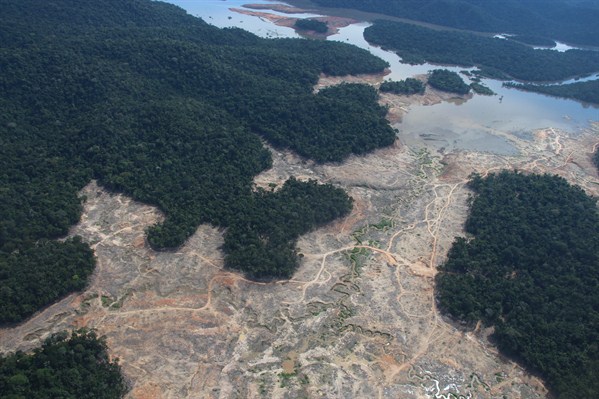From 2004 to 2012, the rate of deforestation in the Brazilian Amazon dropped more than 80 percent, even as Brazil’s agricultural production continued to grow. But that progress in protecting a fragile and essential ecosystem reversed in recent years, before the outlook got
even worse.
First, U.S. President Donald Trump launched a trade war with China, shifting more Chinese demand for soybean products from the United States to Brazil, potentially leading to more deforestation to meet the demands of Brazilian agriculture. Then, last month Brazilians elected the far-right Jair Bolsonaro as president, a major supporter of agribusiness who has vowed to put economic growth over environmental protection. That combination could mean a surge in deforestation in the Amazon with serious implications not just for the Brazilians most directly affected, but for the wider world.
The Amazon basin is home to the world’s largest rainforest. Its trees release carbon dioxide when cut down or burned, and sequester it when planted or left in place. The pace of deforestation, especially in tropical areas like Brazil, has become a major contributor to climate change, as large in the aggregate as the European Union’s greenhouse gas emissions. Reversing those trends could reduce global emissions by even more—as much as 30 percent according to some estimates.
Rainforests like the Amazon’s are also important for global biodiversity and local resilience. In addition to the ecological benefits it provides, biodiversity creates economic opportunities through eco-tourism and sources of new pharmaceutical products. Forests also contribute to localized amenities, such as clean water and protection from climate-related disasters that include flooding and mudslides, as well as drought. Reducing tropical deforestation could
stem the temperature rise due to greenhouse gas emissions faster and more cost-effectively than other options, according to researchers at the Center for Global Development.
Until recently, Brazil was one of the world’s success stories in the fight against deforestation. It was the result of a multifaceted policy that included private sector and public policy changes to reduce demand for deforested land, as well as stronger law enforcement to raise the risk of illegal forest clearing. Brazilian policymakers focused on forest areas that were most at risk from current economic activities. They created new national parks and “extractive reserves,” where rubber tapping—extracting latex from rubber trees—or other sustainable economic activities were permitted, but clear-cutting forest was not. They also empowered indigenous peoples for whom the rainforests are a way of life, and slowed the building of roads in more remote areas.
Accelerating deforestation in the Amazon is the latest stark reminder that elections, and trade wars, often have unintended or unexpected consequences.
Public and private actors then worked to shift the economic incentives in favor of preserving rather than destroying forests. Though small, a conservation program known as Bolsa Floresta has paid people in sensitive rural areas to preserve the forest and the ecosystem services that it provides, such as cleaner water downstream. On the private sector side, protests against big agribusiness, primarily based in the United States and Europe and importing soybeans from Brazil, led those companies to adopt policies discouraging deforestation in their supply chains. In 2006, major international traders and buyers agreed with the major trade associations representing Brazilian growers that soybeans would no longer come from newly deforested areas. Since then, the share of new cropland that has been developed for soy production at the expense of forests dropped from 30 percent to less than 1 percent.
But Bolsonaro’s election now poses the most
direct threat to this progress in the Amazon. He has proposed loosening the enforcement of environmental regulations, as well as combining the ministries for agriculture and the environment, so that farming takes priority over conservation. “We won’t have any more fights over this,”
he said during the campaign. Bolsonaro also threatened to follow Trump in withdrawing from the Paris climate change agreement, though he subsequently walked that back. Even if Bolsonaro pursues no formal legal changes, the downgrading of rainforest protection as a governmental priority is likely to mean fewer resources and less rigorous enforcement of existing environmental laws, which could lead to higher rates of deforestation again.
Meanwhile, the U.S.-China trade war poses risks to the voluntary, private sector moratorium on soy exports linked to deforestation. American farmers grow and export a lot of soybeans, and over the past few years more than half of the exports have
gone to China. China has
more pigs than the United States has people, and soy protein is a major feedstock for the pork industry. Between them, U.S. and Brazilian farmers supplied
80 percent of the oilseeds imported by China in 2016 and 2017. With just the threat of tariffs in the air, the Brazilian share of the Chinese oilseeds market jumped to nearly half in 2017, while the American share dropped to a third, according to the United Nations’
trade database.
The tit-for-tat tariffs that China imposed on U.S. exports this year hit American agriculture hard, and
soybeans in particular. With American exports now subject to a 25 percent tariff, China is increasingly looking to Brazil and other South American countries to replace them. The initial response was a
spike in prices for Brazilian soybeans, which increases the incentives to convert more Amazon forest to farmland by clear-cutting. Since Chinese buyers are generally less sensitive to consumer and activist pressures, this shift in demand could undermine the private sector efforts in Brazil to reduce deforestation pressures related to soy production.
Accelerating deforestation in the Amazon could be one of the most serious global outcomes of the confluence of an election won by a far-right candidate in Brazil with the U.S.-China trade war launched by Trump. It is the latest stark reminder that elections, and trade wars, often have unintended or unexpected consequences.
Kimberly Ann Elliott is a visiting scholar at the George Washington University Institute for International Economic Policy, and a visiting fellow with the Center for Global Development. Her WPR column appears every Tuesday.

